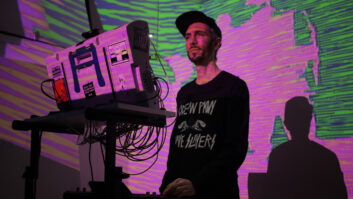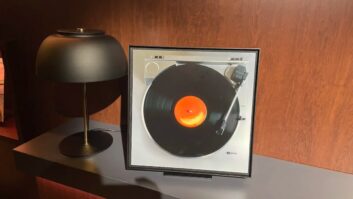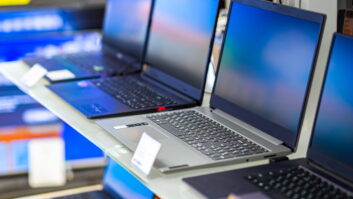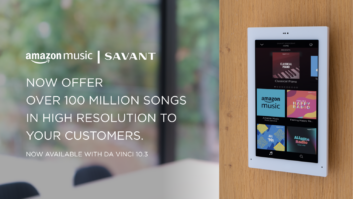Aiwa isn’t abandoning its traditional audio-product categories, but this year it is launching about a dozen products as part of an effort to become “a major player in PC audio,” said Masaru Hirauchi, president of Aiwa Business Center in Japan.
“People are not listening to music as they used to,” he said. “Almost 98 percent of people in the U.S. use the PC to listen to music at work and at home.” For these consumers, he said, Aiwa has developed almost a dozen products “that can be used with the PC to enjoy music.” The products include the company’s first flash-memory and hard-disc-drive (HDD) headphone portables and its first computer-speaker systems.
One of two HDD headphone stereos is described as the industry’s thinnest and lightest HDD model. It’s about the size of a business-card holder.
Of three USB speaker systems, one is a small, single-enclosure model that delivers left and right channels and sits behind a laptop PC or desktop PC to minimize desktop clutter.
Unlike most flash-memory portables, three of Aiwa’s four flash-memory portables will play back music stored on plug-in USB drives. One of the three portables is a water-resistant battery-powered shower radio. A second USB portable is a headphone stereo with USB socket and controls built right into the headphones. The third USB portable is an armband-style portable with FM tuner.
The fourth portable, a headphone stereo, lacks USB but integrates embedded memory and controls into the headphones. It is one of few flash portables with built-in MP3 encoder.
All of the music portables play back MP3 and feature USB 2.0 ports. The headphone stereos ship with 128MB of memory, and the shower radio features 32MB. Optional 256MB USB drives are available.
Most of the products will ship in March at prices that will be competitive with “first-tier brands,” said Hiroshi Takahashi, president of Aiwa Strategic Accounts Partnership (ASAP), Aiwa’s U.S. business unit. In June, the company plans its first digital-still camera, also with plug-in USB drive, he said.
In other changes, the company slightly scaled back its selection of traditional home shelf systems and CD-based portables. Aiwa has also dropped out of the HTiB, DVD and VCR businesses, at least for now. Last year, Aiwa offered a single DVD player, one DVD-VCR combo and one VCR. “Nothing concrete is planned for this year,” a spokesman said of the categories.
Aiwa also exited the small-screen TV and TV/VCR categories, at least for now. The company introduced a small selection of these products in early 2003 as part of a “private space” initiative to increase focus on small audio and video products that could be enjoyed in bedrooms, bathrooms, studies and venues away from the living room or office.
The private-space initiative was announced in January 2003 along with a PC-audio initiative, which in 2003 consisted of mini systems with USB ports.
The PC audio initiative will be expanded significantly in 2004 with the following products:
HDD portables: The HZ-WS2000 is the size of a business-card holder and weighs 2.74 ounces, including rechargeable lithium-ion battery that delivers eight hours of operation. It features 2GB disk drive, enough for 500 MP3 files encoded at 128Mbps, or 30 hours of near-CD-quality music. A wired LCD remote control features jog shuttle.
A second 2GB HDD portable, the HZ-DS2000, is a described by Aiwa as a rugged, splash-proof model with an 18-minute memory buffer intended to prevent skipping and crashing during active use. Users press a button to load the memory with music from a hard drive. Once the buffer is empty, users press the button again to reload. It operates for 8 hours on its rechargeable lithium-ion battery.
Both HDD portables feature MP3 encoders and will be priced below $249, a spokesman said.
Flash-memory portables: Four portables comprise the series. Three of four models use removable USB drives rather than embedded memory to store music “so that capacity is not an issue,” Takahashi explained. In addition, no cables are needed to plug the portables into a PC to load music. Aiwa chose USB over other types of flash-memory media because of universality, he said. “Every PC now comes with a USB port,” Takahashi said.
For the USB portables, Aiwa offers proprietary low-power-consumption USB drives. Because of the physical design of the portables’ USB ports, many other-brand USB drives won’t fit, the company noted.
Two portables that operate on a single AAA battery deliver 10 hours of battery life.
Pricing wasn’t available.
USB speakers: Three USB speaker systems, due April, feature built-in sound cards. Pricing wasn’t available. One is the single-enclosure UZ-US201, a hardcover-book-size model with three drivers firing up and a woofer firing forward. The upward-firing drivers expand the soundfield because one delivers L-R information, one delivers R+L information and the third delivers R-L information, a spokesman said.
A second speaker system is said to be the industry’s only 3.1-channel system, which features virtual surround processing and delivers center-channel information through its two left/right speakers. Each speaker enclosure includes a separate driver dedicated to reproducing center-channel information. An outboard subwoofer is included.
A 5.1-channel speaker system adds two surround speakers to the 3.1 system’s speaker complement as well as DTS, Dolby Digital, and Dolby Pro Logic II decoding.
All products will be available to retailers as well as on the company’s Web site. Last November, the company made its full line of products available online.













